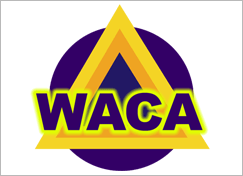

 Today is Wednesday November 4 2015
Today is Wednesday November 4 2015




PAINTERS & WALLCOVERERSPainters Joint Apprenticeship Committee1701 Whitney Mesa Drive #106 Henderson, NV 89014 it (702) 438-2611 FAX (702) 891-5237 |
Nature of Work:
The first priority of the PAINTERS, INDUSTRIAL PAINTERS and WALLCOVERERS is to
Prepare the surface for the finishes to be applied. Some of the processes that are used are
wash, scrape, wire brush or sand and, in some cases, use chemicals, electric scrapers, and
blasters or blow torches to remove old paint, it is the job of the applicator to sand any
irregularities, fill crack and holes, and remove excess dirt and grease.
The PAINTER uses three major tools to apply paints and coatings: The spray gun, the roller and the brush.
The skilled PAINTER knows and uses what is best for each job. Although some PAINTERS do all types of painting most specialize in one type, such as interior or exterior work, new construction, signs, remodeling, particular structures and building ( apartments, homes, bridges Water tanks, structural steel), special effects and decorative designs, metal surfaces or Transportation equipment.
It is the task of the INDUSTRIAL PAINTER to remove previous coatings and prepare coatings And prepare substrates and surfaces for application of coatings and to apply those coatings where necessary on industrial structures. The INDUSTRIAL PAINTER must possess an Interprovincial trade qualification seal or a provincial certificate of apprenticeship as required.
The INDUSTRIAL PAINTER must be skilled in surface preparation and coating application Techniques. He or she must also be familiar with safety requirements of the job site, with the equipment associated with industrial painting, with personal and environmental hygiene practices and requirements of the trade. Due to the risks associated with this work, the Industrial painter must be physically fit and not intimidated with the height of the work.
The WALLCOVERER measures the surface he is to cover and cuts the covering to fit. Next he mixes the adhesive, applies it to the back of the strip of the covering, places the strip in correct position on the wall and smooths it with a smoothing brush or knife. He is very careful to match the paper pattern, making sure the design continues from strip to strip without visible break.
PAINTERS AND WALLCOVERS may also estimate material, time and cost of each job, produce decorative designs, restore natural wood color by bleaching or refinishing, or apply special coatings.
Physical Demands:
Medium work: Should be able to lift or carry up to 50 pounds; frequent lifting or carrying 5 gallon paint cans. Should be able to climb a ladder, balance on a swing stage, be able to perform in small restricted areas and see what is happening around him.
Base Wage for Apprenticeship is 45% of journeyman scale.
Benefits Under Union:
Health and Welfare, vacation, apprenticeship fund industry promotion, pension (national)
Working Conditions:
Painting is strenuous work, requiring much walking, standing, reaching, kneeling, stooping,
climbing and carrying, Occupational hazards include falls from ladder or scaffolds, and skin or
throat irritations from paint fumes and thinners. Exterior painters lose some work time each
year due to bad weather. Interior painters work primarily on new construction may lose work
time during slowdowns in construction activity.
Training duration:
Minimum of three (3) years related instruction classes in all subjects related to the trade for at
least 432 hours, or 144 hours during each year of the term of apprenticeship.
A minimum of 6,000 hours of on the job training. Related instruction includes color mixing and
matching, preparation of surfaces, special finishes, special textures, handling of tools.
Wall covering, spray painting, blueprint reading O.S.H.A certification. CPR-First Aid certification,
lead abatement certification, respirator certification and other safety related classes.
Applicants must meet the following requirements
- Age: at least 18 years of age (birth certificate required) or current drivers license
- Education: High School Diploma or G.E.D. Equivalent
- Aptitude Test: Required for applicants
- Physical ability as related to trade
- Interest
- Attitude
- Personal Traits
- Drug test
The apprenticeship course in three years in which you learn to become a Professional Painter. Instruction includes preparation, care and use of equipments and tools, special texturing, hanging vinyl, wallpaper, modern coatings.
The apprenticeship Standards provide that applications will be received without regard to race, color, religion, national origin or sex. Minorities and women are encourages to apply.
All Rights Reserved. © 2006.